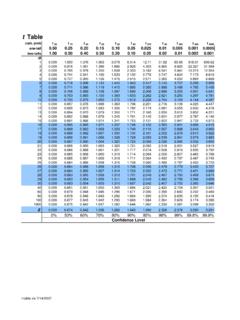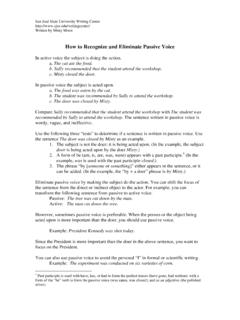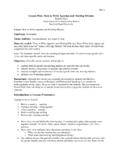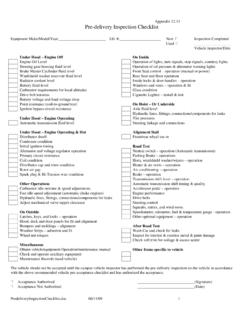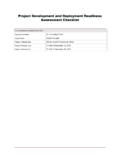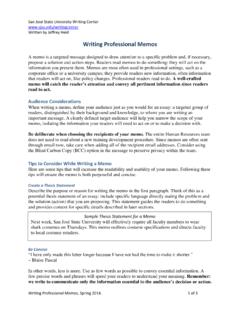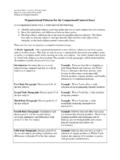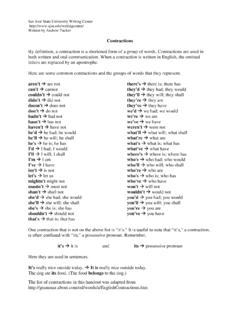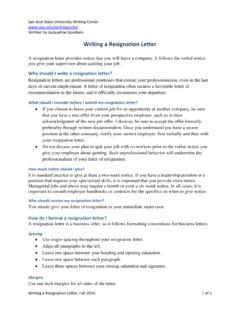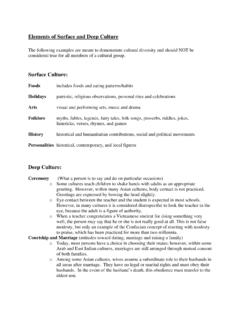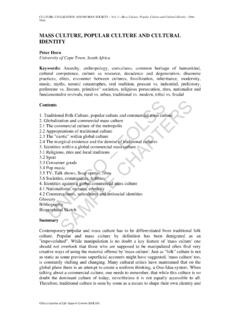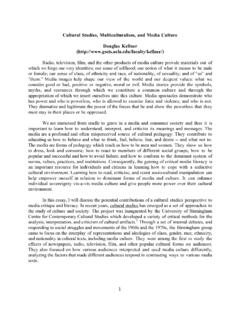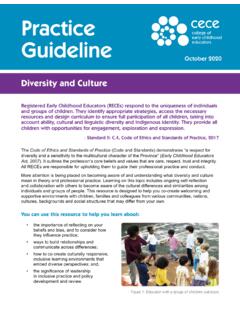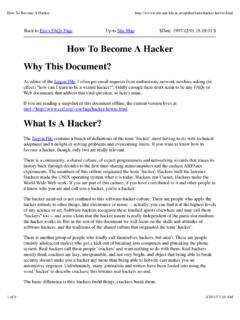Transcription of OTHER ACTIVITIES FOR TEACHING ABOUT CULTURE AND …
1 CULTURE -More ACTIVITIES , Mukhopadhyay. 2006, p. 1 1 OTHER ACTIVITIES FOR TEACHING ABOUT CULTURE AND HOW CULTURE SHAPES HOW WE EXPERIENCE REALITY. Developed by Carol C. Mukhopadhyay Copyright 2006. For relevant conceptual background material, and for links with TEACHING ABOUT Race, see chapters 5 and 6, by Mukhopadhyay in How Real is Race? A Sourcebook on Race, CULTURE , And Biology. 2nd Edition. C. Mukhopadhyay, R. Henze, and Y. T. Moses, 2014. Altamira Press Overview: These short ACTIVITIES further illustrate the subtle power of CULTURE on individual experience. Overall, the objective is for students to understand and be able to provide concrete examples of how CULTURE shapes how we experience reality -- what we see, hear, perceive, the labels we use, and our emotional responses.
2 These can each be applied to understanding how we experience race in the United States. Activity 1: Title and Brief Description: The Impact of CULTURE on our Perception of the World. Map Exercise CULTURE influences how we perceive the physical world, as illustrated in this map exercise. We can t see or draw everything. So we notice selectively. How we think ABOUT (and represent) the world in a map reflects one s cultural, microcultural and personal perspective. We tend to draw what is salient to us. This exercise also can be used to discuss the Eurocentric focus of our CULTURE (and educational system) and long-standing ethnocentric attitudes (and ignorance) ABOUT Africa and Asia.
3 This activity can be linked to OTHER material on racial attitudes, racial policies, and racism in the United States. Objectives: Students should be able to: 1. Explain the notion that CULTURE (along with our personal experience) affects our perception of the physical universe, using the drawing of a map as an example. 2. Be able to draw several maps that reflect perceptions of the world from the view of different cultures or micro-cultures. 3. Be able to give some reasons why different cultural or microcultural groups might produce different maps. CULTURE -More ACTIVITIES , Mukhopadhyay. 2006, p.
4 2 2 4. Be able to recognize areas of bias that exist in the maps used in many schools. Appropriate For: all grade and age levels Time Requirements: At least 15 minutes can go longer depending on class responses and the amount of variability (ethnicity, nationality) in class. Materials: Students need paper and pencils. It would also be useful to have at least two world maps, one showing standard projection with North and South America in the center; the OTHER a polar projection. These can be visual representations of maps, such as from a computer projection. One could also use maps from different historical periods.
5 These are often available on-line. Or one could use world maps published in different countries ( Israel, Syria, India, Pakistan, China, Germany, , Iraq, France). After using this lesson with several classes, representative student sample maps can be saved and used with subsequent classes. Procedure: 1. Ask students to draw a map of the world. Assure them it is not a test of their map-drawing ability. But suggest they do the best job possible. Ask them to label different areas on their map. Give them 5-10 minutes for the drawing. 2. Upon completion of the map, have them reflect on the maps they produced, thinking ABOUT each of the following.
6 A. The relative placement of each continent on the paper ( which was central, which peripheral). b. The relative size of continents and which are labeled. c. Which continents have the most and least detail ( include names of countries) and what this might reflect. Compare especially the United States and Europe with OTHER parts of the world. d. Whether Africa s land connection to the Arabian Peninsula is included or whether Africa is seen as separate isolated continent. 3. Compare their maps to a published map of the world or a globe. How do the differences between their maps and the official maps reflect cultural bias?
7 Does it also reflect the significance of different regions in students own lives? Does it reflect their own ethnic or national backgrounds? Places they have visited? Make the point that all cultures tend to focus on their own CULTURE or region and often see themselves as the center of the world. However, this is even more the CULTURE -More ACTIVITIES , Mukhopadhyay. 2006, p. 3 3 case with powerful, dominant, world cultures. These cultures also tend to make the maps and control vast areas of the world, forcing small, less powerful cultures to see the world from their perspective. In the United States, northwestern European (Anglo) CULTURE has been the most dominant CULTURE and historically has viewed itself as superior to OTHER cultures.
8 OTHER cultural regions, especially non-western cultures, have been largely ignored in public life and in the school curriculum. This is true for virtually all non-European cultures. But it is perhaps most striking in the case of African nations and cultures, even though those with African ancestry (African Americans) have been in the since the 1600s. This will be likely apparent in the maps students draw, which will tend to be European-centric with little detail ABOUT the African continent. Moreover, even though Egypt spans both Africa and the Arabian peninsula, Egypt (and Egyptian civilization) has traditionally been taught in a way that it is not associated with Africa.
9 This is also probably reflected in students maps. Re-emphasize the point that different cultures have different perspectives on the world and on events in the world. 4. Have students examine their own maps to see if they reflect their own family backgrounds or experiences (ethnic, racial, nationality, family ties, etc.) 5. If possible, introduce maps from OTHER countries or historical periods and discuss how those maps reflect particular perspectives on the world derived from the experience and values of the mapmaker. 6. Try imagining what the maps might look like if this exercise was done in a similar classroom of students in such places as: India, Nigeria, Egypt, Iraq, Pakistan, Israel, Syria, South Africa, Mexico, Chile, Alaska, the Philippines, Japan.
10 What would be East and West from this perspective? 7. Examine the maps available in your school, textbooks, or classrooms. What perspective is presented here? What might be the impact of exposure to only this perspective? How might this affect one s attitudes ABOUT OTHER countries? What would be the value of introducing maps with OTHER perspectives ? How might this ultimately help students as future adults to understand world affairs? Assessment ACTIVITIES : Students will construct a hypothetical map of the world as seen from the perspective of someone from a different ethnic group in the United States ( African-American, Filipino-American, Irish-American, Mexican-American, Indo-American, Jamaican-American, Italian-American, Native American, etc.)

